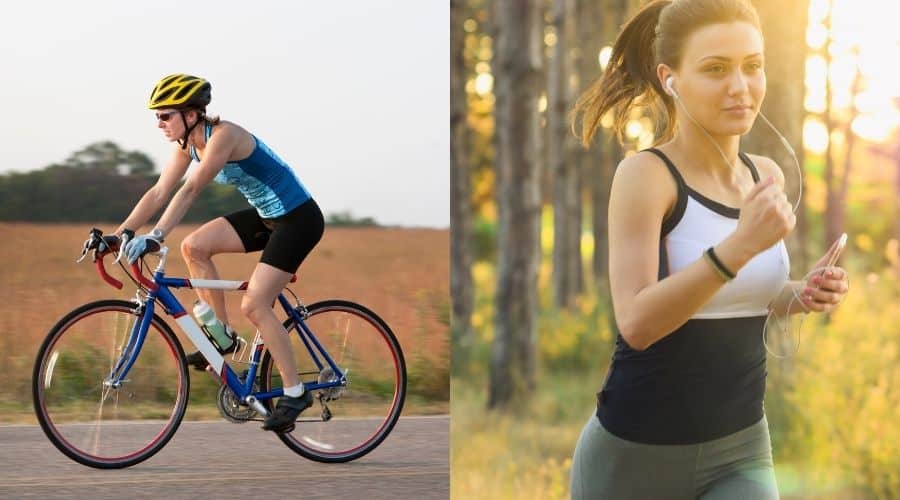You exert a lot more energy when you run than when you ride a bicycle. However, both exercises are an excellent way to lower blood pressure, increase cardiovascular health, and stay fit.
Still, the two actions can be tricky to compare accurately since running is high-impact and cycling is not. What is the best way to convert biking miles to running miles?
The best way to convert biking miles to running miles is using a 1:3 or 1:2 run to bike ratio in miles, meaning that 1 mile of running equals 3 miles of cycling. You need to double or triple the distance for a similar workout since cycling takes far less effort and covers ground more quickly, thanks to the wheels.
Recommended Gear
To see all of my up-to-date recommendations for bikes and cycling gear, check out this resource that I made for you!
Table of Contents
Convert Bike Miles To Walking Miles
A basic equation is the best way to convert bike miles to walking miles. You should multiply B or ‘bike miles’ by 0.3-0.2 to get the total number of walking miles.
The slower your pace, the smaller the multiplier should be, but most people go with a simple Bx0.3= (your answer).
So, let’s say you cycle for 15 miles. Take 15 and multiply that by 0.3. The answer, in this case, is 4.5 miles, so your walking equivalent is 4.5 miles as well.
If you were walking more slowly, it would be 15×0.2 instead, which works out to three miles.
Bike Miles To Running Miles Calculator
Bike miles to running miles isn’t exactly the same under all circumstances. However, there’s a practical way to calculate the equivalent for most people.
A proper estimate is that 2-3 miles of biking are approximately equal to 1 mile of running, a ratio of 2:1-3:1.
You use more energy on foot because your body is doing a high-impact activity when running versus a machine-assisted low-impact workout with bicycling.
That means you need to bike further to use up the same calories and get the same workout you’d get running.
However, the number of calories burned also varies based on your body weight, just as your average speed varies based on your fitness and terrain.
Similarly, the type of bike you ride and factors like traffic and wind affect your cycling speed, so you can only get a good estimate, not a perfect conversion.
Bike Miles To Running Miles
| Miles On Bike | Equivalent When Running |
| 2 – 3 miles | 1 mile |
| 4 – 6 miles | 2 miles |
| 6 – 9 miles | 3 miles |
| 10 – 15 miles | 5 miles |
| 20 – 30 miles | 10 miles |
| 40 – 60 miles | 20 miles |
| 50 – 75 miles | 25 miles |
| 60 – 90 miles | 30 miles |
| 80 – 120 miles | 40 miles |
| 100 – 150 miles | 50 miles |
| 200 – 300 miles | 100 miles |
Bike Miles vs Running Miles
Biking miles versus running miles have a lot in common. For example, both are excellent for cardiovascular health, and they are both aerobic activities.
However, there are a few significant differences.
Biking is low impact, while running is high impact, which means the former is much easier on your joints and less likely to cause damage.
Alternately, the latter, runners, burn more calories in a mile than a typical cyclist.
Perhaps most surprising is that riding a bike has a lower incidence of injuries because you move all your extremities when you run.
How Many Miles On A Bike Is Equal To 1 Mile Walking
It might surprise you to learn that you use the same ratios to figure out how many miles on a bike is equal to 1 mile walking as you would for running.
For most people, the difference between a walk and a run isn’t as significant as you might think. You don’t burn a whole lot more calories.
So, you would still use the 1:3-1:2 ratio and the equation Bx0.3 or Bx0.2 to get the correct answer.
I recommend going with the smaller ratio since walking is slower. Plus, it makes the calculation very simple since you have to bike 2 miles for every one mile of walking.
Most people can multiply and divide by 2 in their heads.
The most significant difference between walking and running is that you always have one foot on the ground when walking.
As a result, walking is a relatively low-impact activity. While a fast runner versus a slow walker can burn nearly twice as many calories, the discrepancy is usually more minor.
Biking 10 Miles Equivalent Running
When comparing biking 10 miles to equivalent running, 1 way to get a similar workout is to compare based on time.
It takes a beginner around 1 hour to ride 10 miles averaging 10 miles per hour. Meanwhile, running 10 miles usually takes 1.5 to 2.5 hours.
In both cases, you are getting a good cardio workout, but running is 1.5-2.5 times as much heart-healthy exercise.
8 Bike Miles To Running Miles
8 bike miles is equivalent to about 3 running miles. However, the 8 bike miles is an easily achievable goal for beginners and typically takes less than 1 hour.
Meanwhile, the 3 miles of running will take around the same amount of time, but it’s a lot harder to manage at first.
If your goal is to build strength and work your way up physically, you may want to start with the cycling and opt for a shorter run, around 5-15 minutes, which is easier for a new runner’s general fitness level.
Cycling Equivalent To Running 5K
We have to do a little math to break down the cycling equivalent of a 5K race. First, it helps to understand that 5 kilometers are approximately 3.11 miles.
Unfortunately, you cannot simply cycle the same 3.11 miles and call it equal. Instead, you’d need to ride 6.22-9.33 miles, which is 10-15k.
As Stephen Simmons points out on Quora, “Most people who enter a local 5k, 10k, half marathon, or even full marathon aren’t actually there to compete or place. They’re there to participate, accomplish something, and maybe try to get a personal best time…The better comparison if you’re looking for distance comparisons would be to compare running races to charity rides, group rides, Fondos, etc., where people aren’t really competing to win the overall ride but to compete against themselves.”
Helpful Tips To Know About Converting Biking Miles To Running Miles
If you want to stay healthy, adding cycling and running to your regular fitness regimen is a good idea.
Although running a mile is different from riding the same distance, the reasons why there’s a discrepancy are also arguments in favor of doing both.
Here are a few more helpful tips to know about converting biking miles to running miles.
- High-impact isn’t always bad news. According to Medical News Today, “Running may be better for long-term bone health than cycling. This is because running causes a higher impact on bone than cycling. Research suggests this higher impact activity may cause bone tissue to signal the pancreas to help meet its metabolic needs over the long term.” Alternately, cycling is likely better for arthritis and joint lubrication.
- Some schools of thought argue that it’s not the distance that matters when comparing biking to running. Instead, these would have you compare time spent or calories burned.
- Most people don’t realize we literally breathe, sweat, and pee out the calories we expend as fat and nutrients are converted into carbon dioxide and water when we use them. That means it is possible to get an exact calculation for how long you need to ride versus running to burn the same number of calories. Unfortunately, you need special equipment because the only truly accurate way to see how many calories a person burn involves measuring their breaths, urine and sweat.
Final Thoughts
When you convert biking miles to running miles, you can use the 3:1 or 2:1 ratio. However, that’s only part of the story.
A beginning cyclist can easily manage an 8-10 mile ride in about 1 hour. Meanwhile, running for 1 hour won’t get you as far, and it’s a lot harder because running is high-impact.
While both of these exercises are great for your health, cycling is much more accessible for most people.
That said, it’s a good idea to include running and riding in a regular workout routine because they have different benefits.


